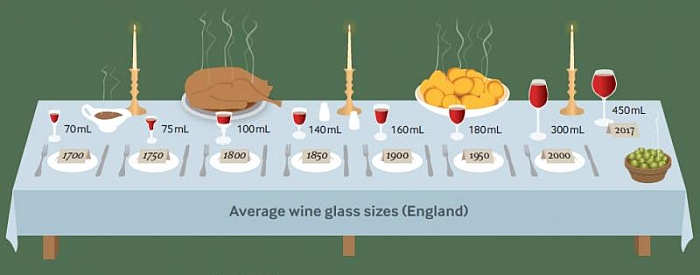Our Georgian forebears definitely drank a lot less wine than we do, but it's not (just) because we're bigger boozehounds. It's because advances in glassmaking and the affordability of wine have allowed for more people to drink it, and from much bigger cups.
How much bigger? Seven times, according to an analysis of 411 wine glasses since 1700. From 66 millilitres (2.2 fluid ounces) to the whopping 449 millilitre mean (15 fluid ounce) wine glasses we use today.
This could have an effect on how much we drink, according to Cambridge University researchers Theresa Marteau and Zorana Zupan.
Alcohol consumption has fluctuated in England over the centuries, tending to be lower during economic downturns, but generally speaking the most popular drinks were beer and spirits such as gin, rum and whisky. Wine was usually consumed by the wealthy upper classes.
Since the 1960s, however, alcohol consumption in general and wine consumption in particular has been rising. Between 1960 and 1980, wine consumption in England almost quadrupled, and almost doubled again between 1980 and 2004.
There are England-specific factors that may account for some of this, such as the introduction of Licensing Acts in 1961 and 1964 that relaxed laws around the sale of alcohol. But some factors may have had a more global effect.
One of these is increased accessibility and lower costs for alcohol products. Another could be glass size. Marteau and a different team established in a study conducted in 2015 that selling wine in larger glasses may cause an increase in alcohol sales and wine consumption.
Now she and Zupan have determined that glass size has slowly increased over the years - and the speed of that increase rose dramatically in the last two decades.
"Wine glasses became a common receptacle from which wine was drunk around 1700," Zupan said.
"This followed the development of lead crystal glassware by George Ravenscroft in the late 17th century, which led to the manufacture of less fragile and larger glasses than was previously possible."
 (The BMJ)
(The BMJ)
But, like anything in history, there's rarely just one single reason for anything.
The team used measurements of 411 glasses, sourced from museums, the Royal Household and shops, from 1700 to the present day, and found that there were a number of factors over the years - not just glassmaking techniques - that contributed to the increasing sizes in wine glasses.
A tax on glassware, for example, ended in 1845, which meant manufacturers started to make larger objects. The Industrial Revolution saw a rise in automated glassmaking during the Victorian era, which also increased production and decreased prices.
Then in the 20th century, wine glasses started to be tailored to different wine varieties to cater to a growing wine appreciation culture. And in the 1990s, a demand for larger glasses came out of the US and spread around the world.
The researchers also suggest in their paper that "A further influence on wine glass size may have come from people running bars and restaurants, as well as their customers. If wine sales increased when it was sold in larger glasses, this may have incentivised vendors to use them more."
I's not currently possible, based on this research, to say that there's a causal link between an increase in glass sizes and an increase in wine consumption, or that reducing one would reduce the other.
However, the authors say, their research does suggest that glass size is an area that requires more research in the context of excessive drinking and population health - and, if there does prove to be a link, regulating glass sizes could prove beneficial.
If you've ever had a red wine hangover, you might be inclined to agree.
The research has been published in The BMJ.
